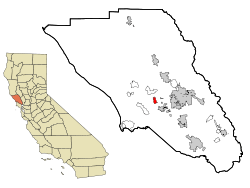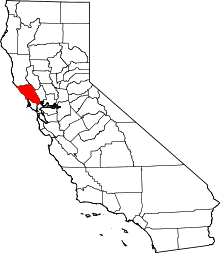Graton, California
| Graton | |
|---|---|
| census-designated place | |
|
Graton storefronts on north side of Graton Road between Ross Road and South Edison Street | |
 Location in Sonoma County and the state of California | |
| Coordinates: 38°26′15″N 122°51′59″W / 38.43750°N 122.86639°WCoordinates: 38°26′15″N 122°51′59″W / 38.43750°N 122.86639°W | |
| Country |
|
| State |
|
| County | Sonoma |
| Area[1] | |
| • Total | 1.579 sq mi (4.090 km2) |
| • Land | 1.579 sq mi (4.090 km2) |
| • Water | 0 sq mi (0 km2) 0% |
| Elevation[2] | 108 ft (33 m) |
| Population (2010) | |
| • Total | 1,707 |
| • Density | 1,100/sq mi (420/km2) |
| Time zone | PST (UTC-8) |
| • Summer (DST) | PDT (UTC-7) |
| ZIP code | 95444 |
| Area code(s) | 707 |
| FIPS code | 06-30812 |
| GNIS feature ID | 1658656 |
Graton is an unincorporated town and census-designated place (CDP) in west Sonoma County, California, United States. The population was 1,707 at the 2010 census. Graton's ZIP code is 95444.
Geography
Graton is located at 38°26′15″N 122°51′59″W / 38.437613°N 122.866375°W.[3] The CDP has a total area of 1.58 sq mi (4.1 km2), all land.[4]
Graton is located at the southeastern end of Green Valley, on the east bank of the seasonally flooding Atascadero Creek. The elevation ranges from approximately 85 feet (26 m) above Mean Sea Level (MSL) at Atascadero Creek to 213 feet (65 m) MSL at Oak Grove School.
Climate
This region experiences warm (but not hot) and dry summers, with no average monthly temperatures above 71.6 °F. According to the Köppen Climate Classification system, Graton has a warm-summer Mediterranean climate, abbreviated "Csb" on climate maps.[5]
| Climate data for Graton (1926-2012) | |||||||||||||
|---|---|---|---|---|---|---|---|---|---|---|---|---|---|
| Month | Jan | Feb | Mar | Apr | May | Jun | Jul | Aug | Sep | Oct | Nov | Dec | Year |
| Record high °F (°C) | 84 (29) |
85 (29) |
90 (32) |
98 (37) |
103 (39) |
108 (42) |
113 (45) |
108 (42) |
112 (44) |
106 (41) |
92 (33) |
81 (27) |
113 (45) |
| Average high °F (°C) | 56.2 (13.4) |
61.3 (16.3) |
65 (18) |
69.5 (20.8) |
74.8 (23.8) |
80.5 (26.9) |
83.3 (28.5) |
83.5 (28.6) |
82.5 (28.1) |
76.2 (24.6) |
65.5 (18.6) |
56.9 (13.8) |
71.3 (21.8) |
| Average low °F (°C) | 35.9 (2.2) |
38 (3) |
39.4 (4.1) |
40.8 (4.9) |
44.2 (6.8) |
47.3 (8.5) |
48.5 (9.2) |
48.2 (9) |
47 (8) |
43.7 (6.5) |
39.2 (4) |
36.2 (2.3) |
42.4 (5.8) |
| Record low °F (°C) | 18 (−8) |
17 (−8) |
25 (−4) |
25 (−4) |
29 (−2) |
33 (1) |
38 (3) |
36 (2) |
33 (1) |
22 (−6) |
22 (−6) |
14 (−10) |
14 (−10) |
| Average precipitation inches (mm) | 8.7 (221) |
7.03 (178.6) |
5.25 (133.4) |
2.62 (66.5) |
1.04 (26.4) |
0.35 (8.9) |
0.04 (1) |
0.1 (3) |
0.35 (8.9) |
2.19 (55.6) |
5.22 (132.6) |
7.87 (199.9) |
40.74 (1,034.8) |
| Average snowfall inches (cm) | 0 (0) |
0 (0) |
0 (0) |
0 (0) |
0 (0) |
0 (0) |
0 (0) |
0 (0) |
0 (0) |
0 (0) |
0 (0) |
0 (0) |
0 (0) |
| Average precipitation days | 13 | 11 | 11 | 7 | 4 | 2 | 0 | 1 | 2 | 5 | 9 | 12 | 77 |
| Source: WRCC[6] | |||||||||||||
Notable
Graton is noted as lying at the approximate furthest southern and eastern extent of Russian colonization of the Americas. Research on Fort Ross has indicated that several farms were developed inland from the coastal fur trading fort in northwestern Sonoma County. These farms or ranches were used for producing additional food and for agricultural projects conducted by Fort Ross's agronomist Yegor Chernykh. In 1836, a farm was established along Purrington Creek, between what are now the towns of Occidental and Graton. There Chernykh erected barracks and five other structures, and grew vegetables, fruit, wheat, and other grains. Chernykh also developed a large vineyard, introducing what has since become a major crop in the area.[7]
Government
Graton is represented by the following elected officials:
- Sonoma County Board of Supervisors: Efren Carillo
- California State Assembly: Jim Wood (Dem)[8]
- California State Senate: Mike McGuire (Dem)[8]
- U.S. House of Representatives (2nd District): Jared Huffman (Dem)[9]
- U.S. Senate: Barbara Boxer (Dem) and Dianne Feinstein (Dem)[9]
Demographics
2010
The 2010 United States Census[10] reported that Graton had a population of 1,707. The population density was 1,080.9 people per square mile (417.3/km²). The racial makeup of Graton was 1,402 (82.1%) White, 10 (0.6%) African American, 29 (1.7%) Native American, 25 (1.5%) Asian, 3 (0.2%) Pacific Islander, 144 (8.4%) from other races, and 94 (5.5%) from two or more races. Hispanic or Latino of any race were 322 persons (18.9%).
The Census reported that 99.2% of the population lived in households and 0.8% lived in non-institutionalized group quarters.
There were 680 households, out of which 193 (28.4%) had children under the age of 18 living in them, 304 (44.7%) were opposite-sex married couples living together, 90 (13.2%) had a female householder with no husband present, 19 (2.8%) had a male householder with no wife present. There were 35 (5.1%) unmarried opposite-sex partnerships, and 18 (2.6%) same-sex married couples or partnerships. 188 households (27.6%) were made up of individuals and 73 (10.7%) had someone living alone who was 65 years of age or older. The average household size was 2.49. There were 413 families (60.7% of all households); the average family size was 3.03.
The population was spread out with 343 people (20.1%) under the age of 18, 131 people (7.7%) aged 18 to 24, 352 people (20.6%) aged 25 to 44, 643 people (37.7%) aged 45 to 64, and 238 people (13.9%) who were 65 years of age or older. The median age was 45.9 years. For every 100 females there were 90.7 males. For every 100 females age 18 and over, there were 86.8 males.
There were 723 housing units at an average density of 457.8 per square mile (176.8/km²), of which 72.2% were owner-occupied and 27.8% were occupied by renters. The homeowner vacancy rate was 0.6%; the rental vacancy rate was 2.6%. 72.0% of the population lived in owner-occupied housing units and 27.2% lived in rental housing units.
The median income for a household in the CDP was $83,082 (+70.4% from 2000), and the median income for a family was $87,641 (+53.9% from 2000). The median per capita income for the CDP was $35,410 (+62.1% from 2000). For comparison, statewide California median per capita income in the 2010 Census was $27,885 (+22.8% from 2000).
2000
As of the census[4] of 2000, there were 1,815 people, 690 households, and 442 families residing in the CDP. The population density was 1,162.1 per square mile (449.2/km²). There were 706 housing units at an average density of 452.0 per square mile (174.7/km²). The racial makeup of the CDP was 84.35% White, 0.50% African American, 1.49% Native American, 1.10% Asian, 0.06% Pacific Islander, 8.98% from other races, and 3.53% from two or more races. Hispanic or Latino of any race were 19.28% of the population.
There were 690 households out of which 30.9% had children under the age of 18 living with them, 49.1% were married couples living together, 10.0% had a female householder with no husband present, and 35.9% were non-families. 27.5% of all households were made up of individuals and 8.8% had someone living alone who was 65 years of age or older. The average household size was 2.60 and the average family size was 3.21.
In the CDP the population was spread out with 24.3% under the age of 18, 8.2% from 18 to 24, 26.0% from 25 to 44, 31.0% from 45 to 64, and 10.5% who were 65 years of age or older. The median age was 40 years. For every 100 females there were 97.5 males. For every 100 females age 18 and over, there were 93.8 males.
The median income for a household in the CDP was $48,750, and the median income for a family was $56,944. Males had a median income of $45,179 versus $43,021 for females. The per capita income for the CDP was $21,844. About 4.0% of families and 10.5% of the population were below the poverty line, including 8.1% of those under age 18 and 14.4% of those age 65 or over.
References
- ↑ "2010 Census U.S. Gazetteer Files – Places – California". United States Census Bureau.
- ↑ U.S. Geological Survey Geographic Names Information System: Graton
- ↑ "US Gazetteer files: 2010, 2000, and 1990". United States Census Bureau. 2011-02-12. Retrieved 2011-04-23.
- 1 2 "American FactFinder". United States Census Bureau. Retrieved 2008-01-31.
- ↑ Climate Summary for Graton, California
- ↑ "GRATON, CA (043578)". Western Regional Climate Center. Retrieved November 29, 2015.
- ↑ "OUTPOST OF AN EMPIRE" by Stephen Watrous, 2001
- 1 2 "Statewide Database". UC Regents. Retrieved December 5, 2014.
- 1 2 "California's 2nd Congressional District - Representatives & District Map". Civic Impulse, LLC. Retrieved March 1, 2013.
- ↑ "2010 Census Interactive Population Search: CA - Graton CDP". U.S. Census Bureau. Retrieved July 12, 2014.
External links
- Graton Day Labor Center
- Graton Community Services District
- Graton Fire Protection District
- community website


